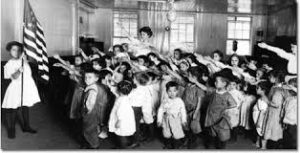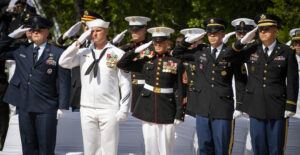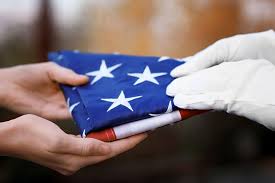Saluting the Flag of the United States
re-spect: v 1) To have deferential regard for; esteem. 2) To treat with propriety or consideration.
pro-to-col: n 1)The rules of diplomatic and state etiquette and ceremony.
RESPECT is a verb, an action. It is important to always show proper respect for the United States Flag.
PROTOCOL defines how we demonstrate our respect for the flag. Much of this is spelled out for us in the Flag Code.
 The flag should never be displayed with the union down, except as a signal of dire distress in instances of extreme danger to life or property.
The flag should never be displayed with the union down, except as a signal of dire distress in instances of extreme danger to life or property.- The flag should never touch anything beneath it, such as the ground, the floor, water, or merchandise.
- The flag should never be carried flat or horizontally, but always aloft and free.
- The flag should never be used as wearing apparel, bedding, or drapery.
- The flag should never be fastened, displayed, used, or stored in such a manner as to permit it to be easily torn, soiled, or damaged in any way.
- The flag should never be used as a covering for a ceiling.
- The flag should never have placed upon it, nor on any part of it, nor attached to it any mark, insignia, letter, word, figure, design, picture, or drawing of any nature.
- The flag should never be used as a receptacle for receiving, holding, or carrying, or delivering anything.
- The flag should never be used for advertising purposes in any manner whatsoever. It should not be embroidered on such articles as cushions or handkerchiefs and the like, printed or otherwise impressed on paper napkins or boxes or anything that is designed for temporary use and discard. Advertising signs should not be fastened to a staff or halyard from which the flag is flown.
- No part of the flag should ever be used as a costume or athletic uniform. However, a flag patch may be affixed to the uniform of military personnel, firemen, policemen, and members of patriotic organizations.
- The flag represents a living country and is itself considered a living thing. Therefore, the lapel flag pin being a replica, should be worn on the left lapel near the heart.
- The flag, when it is in such condition that it is no longer a fitting emblem for display, should be destroyed in a dignified way, preferably by burning.
The Hand Salute
 The Pledge of Allegiance to the flag was born in America's schools on Columbus Day in 1892. For almost 30 years Americans, led by school children, recited the Pledge of Allegiance with no written protocol.
The Pledge of Allegiance to the flag was born in America's schools on Columbus Day in 1892. For almost 30 years Americans, led by school children, recited the Pledge of Allegiance with no written protocol.
Initially, the pledge was written:
"I Pledge Allegiance to my flag and to the Republic for which it stands......."
Those reciting the pledge usually stood, faced the flag, and recited these words. The "hand salute" was given at the words "my flag", when the right hand was outstretched towards the flag, palm up.
 In the early part of this century, written protocol began to be developed for showing proper respect for the flag. It was also during this time that Adolph Hitler came to power in Europe and began his quest to conquer the world. The "seig heil" German salute with the right arm outstretched palm down, became a symbol of tyranny and oppression. As the Flag Code was developing, two major changes also occurred. First, the words in the Pledge of Allegiance were changed, so that the Pledge was rendered to "The Flag of the United States of America" rather than "My Flag". Second, a new hand-salute was introduced less similar to the seig heil. The new salute involved placing the right hand on the left side of the breast, covering the heart, to show our love for the Flag and all it stands for.
In the early part of this century, written protocol began to be developed for showing proper respect for the flag. It was also during this time that Adolph Hitler came to power in Europe and began his quest to conquer the world. The "seig heil" German salute with the right arm outstretched palm down, became a symbol of tyranny and oppression. As the Flag Code was developing, two major changes also occurred. First, the words in the Pledge of Allegiance were changed, so that the Pledge was rendered to "The Flag of the United States of America" rather than "My Flag". Second, a new hand-salute was introduced less similar to the seig heil. The new salute involved placing the right hand on the left side of the breast, covering the heart, to show our love for the Flag and all it stands for.
The military salute is rendered by men and women in uniform (and may also include boys and girls in the uniform of Scouts, CAPS, ROTC, and others). Those not in uniform salute the flag by standing at attention, tall and straight with the left arm at the side, and placing the right hand over the heart. Men who are wearing a hat should remove the hat with their right hand and hold it over their shoulder. The right hand, not the hat, should rest over the heart.
This salute is presented at several important times:
- When the Flag is being raised or lowered from the flag pole.
- When the Flag is passing by, as in a parade or Flag ceremony
- When reciting the Pledge of Allegiance to the Flag.
- At the Playing of our National Anthem.
During these, and other appropriate occasions, the Flag Code establishes the proper protocol to practice in saluting and showing respect for the flag: All persons present except those in uniform should face the flag and stand at attention with the right hand over the heart. Those present in uniform should render the military salute. When not in uniform, men should remove their headdress (hat) with their right hand and hold it at the left shoulder, the hand being over the heart. Aliens should stand at attention.
- When the flag is being raised or lowered the salute should be given at the moment the process begins and be held until the flag has been raised to the top of the pole or lowered to its base.
- When the flag is passing by as in a parade or flag ceremony, the salute should be given at the moment the flag passes your position, and held until it has passed by.
- When the Pledge of Allegiance is being given, the hand-salute should be given before the first words are spoken, and held until the last words have been spoken. Often someone will be delegated to lead in the Pledge of Allegiance. In these circumstances, the leader will often give instructions or a command to render the salute, and then to drop the salute.
- When the national anthem is played, the salute should be given at the opening note and held until the last note has been played.
The Military Salute

The Military Salute is rendered by men and women in full uniform (including a "cover" or hat). The salute is given from a position of full attention, standing straight with the left arm at the side, hand against the thigh and the fingertips curled slightly inward. The feet should be placed with the heels together, the toes pointing outward at a 45-degree angle (not together).
The salute is rendered by bringing the right arm up so that the lower part of the upper arm is horizontal from the body at a 90-degree angle, and the forearm is held at a 45-degree angle towards the brow. The thumb and fingers of the right hand are closed comfortably but firmly, the forefinger touching the brim of the cap just to the right of center, palm down. (When uncovered...meaning you are not wearing a hat...the forefinger should be at the top/center of the right eyebrow). Military men and women render the salute with all 4 fingers of the hand extended and parallel. Some organizations, such as Scouts, have different configurations for the fingers in rendering the salute.
The Flag Code states that, when giving the Pledge of Allegiance, "Persons in uniform should remain silent, face the flag, and render the military salute." When the pledge is given, if you see a man or woman in uniform saluting but not reciting the pledge, that is the reason for their silence.
